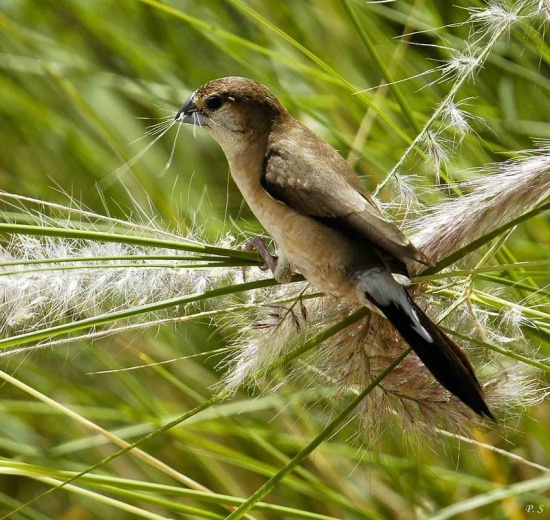| Line 1: | Line 1: | ||
| + | '''Alternative names: Indian Silverbill or Warbling Silverbill as well as ''Euodice malabarica''''' | ||
| + | |||
;[[: Category:Lonchura|Lonchura]] malabarica | ;[[: Category:Lonchura|Lonchura]] malabarica | ||
| − | + | ||
[[Image:White-throated_Munia.jpg|thumb|550px|right|Photo by patrick123_2000<br />Photo taken: Arabian Gulf.]] | [[Image:White-throated_Munia.jpg|thumb|550px|right|Photo by patrick123_2000<br />Photo taken: Arabian Gulf.]] | ||
==Identification== | ==Identification== | ||
| − | + | 11 cm long. Creamy underside with darker upperside, often displaying dark to black primaries along the lower edge of the folded wing, as well as a dark tail that is often somewhat pointed. White rump is sometimes visible on the sitting bird, and always visible in flight. Bill has a dark, curved, upper mandible while the lower mandible is lighter often reflecting. | |
This species is very similar to [[African Silverbill]] (''Lonchura cantans'') but differ in showing a white rump (dark in the African species). | This species is very similar to [[African Silverbill]] (''Lonchura cantans'') but differ in showing a white rump (dark in the African species). | ||
| Line 13: | Line 15: | ||
==Habitat== | ==Habitat== | ||
| + | Dry open country and cultivation, especially near water. | ||
| + | ==Behaviour== | ||
| + | The diet includes seeds, especially grass seeds. | ||
| + | |||
| + | The nest is a large domed grass structure in a tree; 4–10 white eggs are laid. | ||
| − | |||
| − | |||
==External Links== | ==External Links== | ||
{{GSearch|Lonchura+malabarica}} | {{GSearch|Lonchura+malabarica}} | ||
| − | [[Category:Birds]][[Category:Lonchura | + | [[Category:Birds]][[Category:Lonchura]] |
Revision as of 13:53, 21 August 2008
Alternative names: Indian Silverbill or Warbling Silverbill as well as Euodice malabarica
- Lonchura malabarica
Identification
11 cm long. Creamy underside with darker upperside, often displaying dark to black primaries along the lower edge of the folded wing, as well as a dark tail that is often somewhat pointed. White rump is sometimes visible on the sitting bird, and always visible in flight. Bill has a dark, curved, upper mandible while the lower mandible is lighter often reflecting.
This species is very similar to African Silverbill (Lonchura cantans) but differ in showing a white rump (dark in the African species).
Distribution
Native distribution seems to have been from the Arabian Peninsula through Iran, to India, Sri Lanka, Nepal, and Sikkim. Populations in Israel and Jordan may have its origin in escaped cage birds, and the same is the case for southern France (e.g., Nice) where the species is considered established, and in Portugal.
Taxonomy
This is a monotypic species, which is sometimes placed in genus Euodice. This taxon has previously been considered conspecific with African Silverbill.
Habitat
Dry open country and cultivation, especially near water.
Behaviour
The diet includes seeds, especially grass seeds.
The nest is a large domed grass structure in a tree; 4–10 white eggs are laid.




